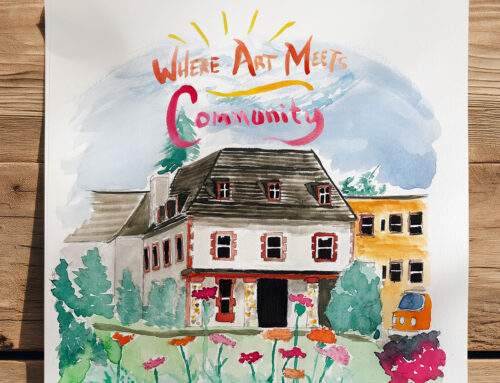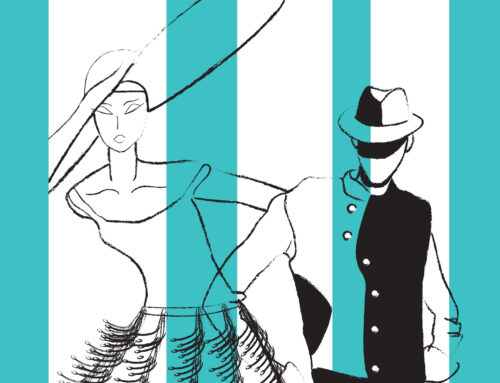Music can regulate the nervous system, reduce pain and heal trauma
Writing by Anastasia Mills Healy
Artwork by Justin Negard
As a graduate student in 1978, when Dr. Concetta Tomaino was assigned to play atmospheric music for the mostly nonresponsive residents of a nursing home in Brooklyn, the staff who fed them through tubes and tied them to their wheelchairs didn’t expect any reaction at all.
“I started singing this song, and people who were totally out of it and catatonic woke up; the ones who were screaming stopped, and then half of them started singing the words to the song,” Tomaino recalls. “Well, this was my epiphany because here I am saying, well, yes, music reaches people emotionally, but these people are processing what I just did, and music is nothing but vibrations in the air, so their brains are still working.”
Tomaino looked for research on this phenomenon, but “there was nothing back then,” she says. Now executive director and co-founder of Mount Vernon’s Institute for Music and Neurologic Function (IMNF), as well as an author, educator and music therapist, Tomaino has not only witnessed the growth of the music therapy field, she has also been a catalyst for it.
“When I started, it was just seen as a superfluous type of profession,” she explains. “Now its validity, both psychotherapeutically and medically, is becoming more recognized.” Tomaino has lectured around the world, received numerous awards, discussed music therapy on programs such as “60 Minutes,” and helped countless people both directly and through her teaching.
Now, “The understanding of music’s role in people with memory impairment and how music can help enhance memory retention as well as reach people in the end stages of dementia has been studied and recognized as important,” she says. Not only that, music therapy is becoming a standard in acute rehabilitation facilities, pediatric hospitals and neonatal intensive care units.
Music and your subconscious
According to the National Center for Complementary and Integrative Health, which is part of the National Institutes of Health, music can manage disease symptoms. Whether passively listening to or actively participating in making music, people suffering from certain conditions have shown improvement when exposed to music-based interventions.
Health Conditions That Respond to Music
- Anxiety Disorders
- Autism Spectrum Disorder (ASD)
- Chronic Obstructive Pulmonary Disorder (COPD)
- Cognitive Impairment and Dementia
- Depression
- Multiple Sclerosis
- Pain
- Parkinson’s Disease
- Stress
- Stroke
- Sleep Problems
Source: National Institutes of Health
Local Teens Use Music to Improve Skills
By Ava Elghanayan
Music can also improve children’s lives, and two teens, one from North Salem and one from South Salem, have experienced this firsthand through their school’s participation in an international music program. “These talented musicians, one who plays the electric bass and the other who plays the clarinet and sings, participate in our annual El Sistema Residency,” says Garrett Mendez, the director of performing arts at Stamford’s King School. “They collaborate in intensive music workshops with visiting students of various El Sistema USA programs, including Stamford’s own Project Music.”
El Sistema, which began in Venezuela, uses music instruction to enhance the lives of students in under-resourced communities and help them improve skills such as patience, persistence and confidence. “Music is the vehicle for them to work together and communicate,” Mendez explains. “Through the process, they learn more about each other and see how their lives are similar in so many ways.”
Music therapy is becoming standard now. “We now understand how music affects brain function and that it can also help regulate physiological function,” Tomaino explains. Plus, we also now know “how the auditory system stimulates these subconscious networks in our bodies and how it connects to the brain.”
Julie Sherwood, MA, LCAT, CCTS, MT-BC, a music therapist at the Music Therapy Institute, which is part of the Music Conservatory of Westchester in White Plains, says, “Our respiration is rhythmic and has its own varying tempo. Our heartbeat is rhythmic and has its own varying tempo. So, we can really use interventions to calm people or, alternatively, to boost their energy. Much of my work with veterans and others experiencing stress, anxiety, trauma, or post-traumatic stress involves using music to help them regulate their nervous systems.”
Things like trauma and PTSD really live in the nervous system and the limbic parts of the brain,” Sherwood continues. “So, we need that bottom-up approach. We need those somatic components.”
According to Harvard Health Publishing, somatic therapy approaches trauma recovery with a dual mind-body strategy to healing. “Somatic therapies…look at the physiology behind our emotions and body sensations, instead of just intellectualizing the process of trying to change what the feelings or symptoms are like in the body,” Sherwood explains. “Think about anxiety or panic attacks and how rooted they are in the nervous system, going into high alert and being flooded by cortisol and adrenaline.”
More than a distraction
There’s a reason nurses hand children lollipops or stickers in doctors’ offices. Distraction is a powerful tool to refocus the mind in stressful situations. But music therapy for pain management and stress is about much more than distraction.
Sherwood explains that when we listen to music we enjoy, our bodies produce dopamine and endorphins, which are natural mood boosters and painkillers, respectively. “We really get a chemistry shift when we engage in music… It really is changing the brain and nerve signals. If we’re intentionally relaxing the body, deepening the breath and slowing the heart rate, that can also help relieve pain,” she says.
Music in neonatal hospital units is becoming standard now because, as Tomaino explains, “it reduces stress in newborns who are surrounded by all these monitors and are in very stressful environments—music can help regulate their breathing and calm them.”
Similarly, studies have found that music therapy can successfully ease the stress in emergency rooms. “I worked with children and adults waiting to get removed or for other painful procedures, and they were terrified, as well as people who came in with suicidal ideation who had to be held for observation,” Sherwood says. “I used music therapy as a calming intervention.”
A person doesn’t have to consciously participate in music therapy to receive the benefits. In a hospital traumatic brain injury unit, Sherwood explains, “We could work with someone who wasn’t even conscious and lower their heart rate and deepen their breathing because of the influence of the music.” When people are conscious and agitated, they often “struggle with impulse control and hyperarousal because the areas of their brain affected by the injury make it difficult for others to communicate with them or for medical professionals to complete their examination. But we’re not necessarily trying to reach the conscious part of the brain; we’re influencing the heart rate and the nervous system. It’s like watching someone transform into a different person as their brain begins to organize and regulate functions more effectively.”
Music interventions for Parkinson’s
Tomaino was at the forefront of research focused on music-based interventions for people with Parkinson’s disease, alongside Dr. Oliver Sacks, who was widely regarded as one of the most brilliant minds in the field of neurology. In fact, a recent Peacock series, “Brilliant Minds,” is based on Sacks, as was the 1990 Academy Award-nominated film “Awakenings,” starring Robin Williams and Robert De Niro.
After a week or two into her first full-time job in 1980 as a music therapist at a hospital in the Bronx, Tomaino received a mysterious “note from interoffice mail, just a torn-off piece of loose-leaf paper with the quote ‘Every disease is a musical problem, every cure a musical solution—Novalis. Welcome, Ollie.’” Tomaino had yet to meet Sacks, so she was unsure who “Ollie” was. But the quote from German poet Georg Philipp Friedrich Freiherr von Hardenberg, whose pen name was Novalis, written circa 1799, was meaningful to Tomaino because it summed up the framework of music therapy and demonstrated that she and Ollie were aligned.
At that time, it was thought that when someone loses brain function, there is no hope for rehabilitation. “Yet here I was working with people every day using music in a very specific way and seeing recovery, which was unheard of,” Tomaino recalls. “People were remembering things; people were walking and moving; people were recovering speech after a stroke.” She and Sacks, who himself had witnessed rhythm and music reanimating people who had been frozen because of this post-encephalitic Parkinson’s disease, together founded the Institute for Music and Neurologic Function.
They observed that, remarkably, people could move in sync with music, even if they couldn’t initiate movement without it. Tomaino explains this happens because when a person has low levels of dopamine, they can’t start moving on their own. But music stimulates neurons to fire in rhythm, which wakes up the motor system and allows the person to walk perfectly as long as the music is playing. With therapy, it’s even possible to train the body so patients can internalize the rhythm enough to walk without music, she says.
DIY music therapy
Sherwood wants readers to know that even though it’s a complex field because they’re “studying psychology and neurology and physiology,” there are many ways people can reap the benefits of music at home, such as creating specific playlists.
To create playlists, first think about the type of experience you want to have, making sure it will invoke positive feelings. For a relaxing one, begin with faster music and progress to slower tunes; go the opposite way (slow to fast) if you need an energy boost.
“There’s no prescription for music that will have the same effect for everyone,” Sherwood explains. “The impact of music comes from each person’s individual relationship with it, including their memories and associations with that specific music. That’s why music therapists do careful assessments of each patient’s needs and their relationship with different types of music, artists, instruments, songs, etc.”
She recommends asking yourself the following questions to figure out what music will work best for you:
- What’s the first album/CD you ever bought?
- What’s the first concert you ever attended?
- What songs are associated with happy events (your wedding, a loved one’s favorite song, etc.)?
- What song always gets you out on the dance floor at a party?
- What song always makes you sing along when it comes on the car radio?
- What song reminds you of someone who makes you feel safe or loved?
Another option is to hum. Singing and humming release oxytocin and create vibrations that stimulate the vagus nerve, which runs down the side of the throat and into the torso, Sherwood explains. “I like to tell people to think of your vagus nerve as your calm button. If you stimulate it, it starts to give you this cascade of calm and releases your stress. People should understand these concepts and be able to think a little more intentionally about how they can use music to make themselves feel good.”
Alternatively, there are music therapists who come to the home. Tomaino hopes Westchester residents will take advantage of the world-renowned music therapy programs available in our area (such as her Institute for Music and Neurologic Function in Mount Vernon or the Music Conservatory of Westchester in White Plains) or, for those who cannot make the trip, find an online or in-home provider.
“We provide in-home music therapy services,” Tomaino says. “We consult on program development. We have training programs. We have community-based programs here on-site. We have access to Zoom programs, so we can pretty much reach anybody in the world. I’ve consulted in hospital rooms in Peru. There’s no limit to who we can help.”
This article was published in the July/August 2025 edition of Connect to Northern Westchester.









